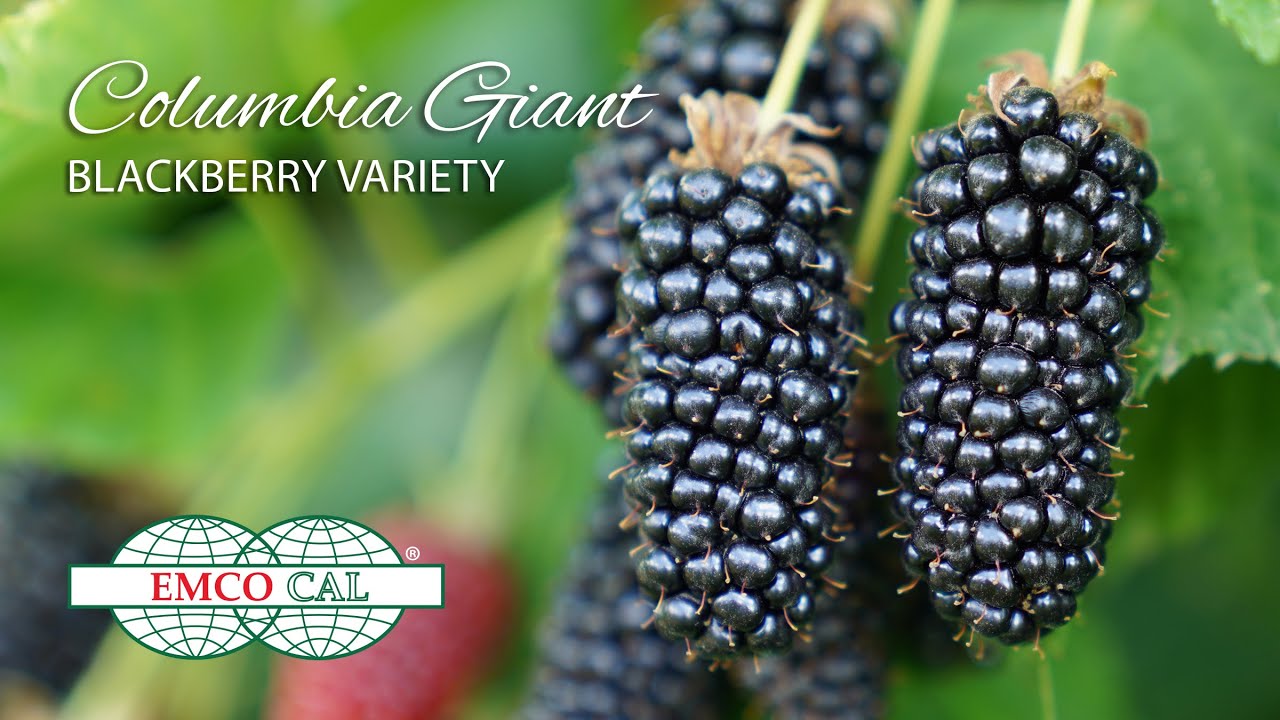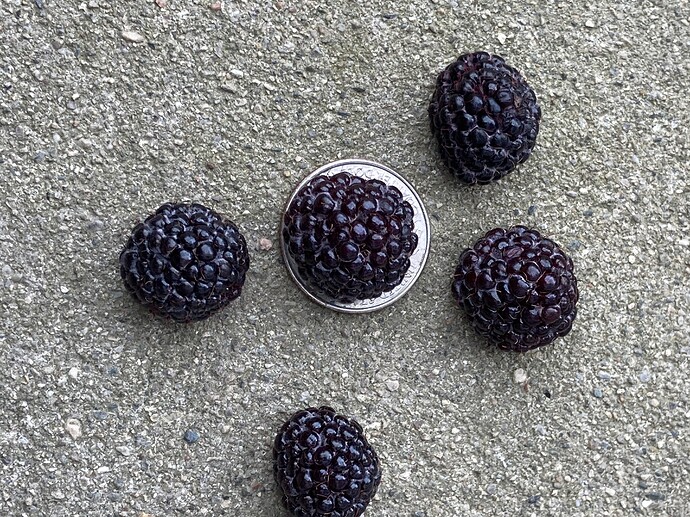Whats the sweetest blackberries to grow
i think this one is one of the sweetest tasting. (not necessary highest brix)
i ordered it this year. But it was not in the package 
So i won’t have any experience with it this year.
Osage and Prime Ark Freedom get pretty sweet here.
I second the Prime Ark Freedom. They are the favorite of the 4-5 varieties I grow. Ironically I got two Sweetie Pie plants thinking they would be sweet but the last two years they have been more tart than sweet.

You may not be able to grow the sweetest blackberries in Z6a.
Most of those may not be cold hardy enough…
This is one I would really like to have, but not sure they would do well here in TN Z7a.
He says they have survived down to zero,… good to about +10 f.
One Green World says Ok to -10 f, Zone 5-8. But now they are selling them.
Think if I grew those I would have to do some type of winter protection.
Many claim that Marion is the best tasting blackberry and with a Brix of 13.7 — I would love to try some of those.
@Bradybb had recommended Hall’s Beauty with the highest Brix! (17). I planted one last summer, its been doing well so far, looking foward to the buds and the fruit!
I have one in the ground in zone 6a. Since it’s a trailing cane I leave on the ground and bury it in leaves. It’s very young. I should get some fruit this year.
I will trellis it in the spring. I have found the western blackberries including the Oregon cultivars in that group. Are hard to establish in colder zones. But once established they produce thick long canes. You still have to protect canes but crown is hardy and will survive. I grew Columbia Star before and that one is hardy here no protection needed for canes. The berries were not as good as New Berry. Some of these others might be fine here too. Once my Columbia Giant is established I will leave some canes exposed and see what happens.
I also grow Marion in a container. I put it in the garage with my figs, pomegranates, and cold sensitive mulberries Pakistan and nigra. I don’t get a lot of berries but certainly savor the ones I get. I also grow New Berry which is an excellent top shelf blackberry. It has a wonderful blackberry flavor with a strong raspberry finish. As complex a flavor as Marion. Fantastic! I never tasted anything like it. I’m experimenting with in ground plants. But keep mama in a container. Just about impossible to find anymore. I don’t get that? It fruits extremely well and is as good as it gets. The berries are very good size too.
Sweetie Pie is supposedly very sweet…but it likes southern climates. Mine do ok in my climate but depending on hydration and climate they are kind of soft.
Ponca is supposedly very sweet… i will know more this year.
Osage is to me the perfect sweet. It has the best balance of sweet to tart. Tastes like what a blackberry jolly rancher would taste like.
The sweetest of all for me is tayberry. When fully ripe it has little if any tartness. Tayberry has a unique flavor and reminds me of strawberries. It tastes more like a gummy bear then a jolly rancher.
Loganberry is a cross between a raspberry and a blackberry.
Tayberry is a cross between Loganberry and Black Raspberry
Boysenberry is a cross between Loganberry, Raspberry and Blackberry.
One that interests me is Wyoming Black Raspberry…which is actually purple. It is a cross of a blackberry and raspberry. I have seen pictures of berries the size or a quarter in good growing conditions…but its a favorite of the cold weather growers…so the berries are smaller there. All reviews point towards it being an excellent berry… but its unobtainable. Unless you live in Canada. Im not entirely sure its classified as a raspberry. Canes grow reported 20 feet or more and is very vigorous. I want to think its superior to Loganberry in taste but not size.
If it is purple that would be the 3rd purple around.
I do favor the hybrids myself. I have an Ontario wild black raspberry and it is disease free, or 100% asymptomatic. I use it in crosses and crossed with Niwot and got a 2 crop Black raspberry.
My cross I call Lynn’s Black
Compared to a quarter
The above is a floricane fruit, the primocane fruits are bigger than quarters

Tayberries are a little smaller here in the cold

My Ontario wild black is not a black cap it is a brown/yellow cap. Gene appears to be recessive. I have to back cross it to get this color.

do you have a source for that?
claims it’s a raspberry blackberry hybrid. And a special 56 chromosome blackberry. And almost all sources if seen claim it’s a red raspberry. (Rubus idaeus)
if not seen any DNA analysis though.
Black raspberry also has chromosome number 2n=14. So it could definitely be possible. (Red and black raspberry’s have also been crossed = glenco)
I planted some too. If I can fight off the deer it should produce a small crop this year
Im not sure where i came up with black raspberry… anyways here is my source which is pretty old.
.
My info came from a Univ of Vermont Extension which is a pretty decent article.
https://pss.uvm.edu/ppp/articles/lesserbram.html
The Loganberry was made in the early 1880’s in California by a horticulturist with this name. It resulted from crossing the European red raspberry cultivar ‘Red Antwerp’ with the American blackberry cultivar ‘Aughinburgh’. The conical red fruit wasn’t flavorful, so not popular, but this hybrid was used in further breeding.
Crossing the loganberry with a raspberry in Scotland in 1962 gave us the Tayberry, named after the Tay river there. Its red fruit are larger and sweeter than the Loganberry, and ripens mid-season.
A cross in the 1980’s in Scotland between the tayberry and a hybrid seedling gave us the Tummelberry. Its deep red fruit are conical, late in the season, and retains the core when picked.
Similar to the tayberry is the Wyeberry, only it is more winter hardy and tolerant of fluctuating temperatures, but quite thorny. It looks like a red raspberry, tastes like one with some boysenberry flavor, and has higher yields than many raspberries but fruit may be hard to pick. It was developed at the University of Maryland.
Many have heard of boysenberries, most likely from syrups or jams, and in particular the ones that made Knott’s Berry Farm famous. This fruit was a 3-way cross between the loganberry, a raspberry, and a blackberry. In the 1920’s, a berry farmer named Knott from southern California and the USDA breeder George Darrow (as in the Darrow and Olallie cultivars, among others) visited the former farm in northern California of a man named Boysen. There they found some vines Boysen had bred, hidden among the weeds. Knott took these back to his farm, nurtured and began cultivating them, and in 1932 began selling the popular large and tasty dark berries at his then farm stand, and named them after their original source. You may find plants both with or without thorns.
The wineberry (R. phoenicolasius) was introduced from Asia both as an ornamental, and to breed with raspberries. It has naturalized since then in the wilds in many areas and has become invasive. The Marionberry is actually just the cultivar Marion of blackberry (named for the county where it was tested in Oregon), being a hybrid of two other blackberries. Similarly, the Olallieberry is the cultivar Olallie (from the Chinook name for berry) —a cross of youngberry and loganberry.
intresting.
I usually find extension sources to be really reliable. But it’s not in agreement with other sources. (like the person who bred the tayberry, or the institute that released it)
After this im done highjacking the thread…
With a little bit of sleuthing…his source is from The Fruit Gardeners Bible…which is a pretty good reference.
The text in question should be highlighted on the link.
If not its on Page 66
Well the book is obviously incorrect. It sucks as we count on books like this. It brings the whole book in doubt now. As the actual breeder who works at a world renowned institute says otherwise.
What I didn’t like was the comments about loganberries. For one they are used a lot in breeding but you can buy plants in multiple places. It certainly is a success by any measure.
Good catch here, great info! That book has passed a lot of misinformation around. I would have thought it was true too.
Wyeberries are nothing like tayberries. And I can’t tell the difference in taste between boysenberry and wyeberry. I grew them side by side for about four years. I observed boysenberry has smaller berries, ripens a week later than wyeberry. And had more cane loss over winter. I was going to keep both but after two years of all canes dying in the winter I removed the boysenberry. The roots were fine. Seems the wyeberry is almost exactly like boysenberry. I got the wyeberry from Edible Landscapes and the boysenberry from Raintree.
well no, but I don’t doubt the breeders claim (he wrote the article). Derek Jennings the breeder has many released cultivars under his belt. He is very well respected. The Tayberry is his, Some great stuff in that article, thanks for the link! . Jennings was working for the Scottish Crop Research Institute that is very well known in the fruit world. I have followed what the UK has been doing with fruits, some awesome work going on. The article mentions a few new cultivars. Work with fruit trees is going on too. I hope to see more out of this program in the future.
Yes i know. That’s why i posted the link from the history of the tayberry (written by him) and the link from Hutton (Scottish Crop Research Institute merged into Hutton)
The breeder and the institute that released the variety seem like the most reliable sources.
However, it was bred and released quite a while ago. When DNA testing was not common. So it’s not unthinkable that there might have been a stray bee or other way that lead to the parents of the tayberry not being a Red raspberry and blackberry but a loganberry and a raspberry.
It would not have been the first fruit variety that years after release was proven to have different parentage than expected.
However until i see proof otherwise, I’m going to assume the tayberry is a cros between a red raspberry and a blackberry.
And specifically
‘Tayberry’ is a hybrid between a tetraploid raspberry and ‘Aurora’ blackberry
btw did anyone notice Nikki Jennings on that page? Probably related to Derek Jennings.


